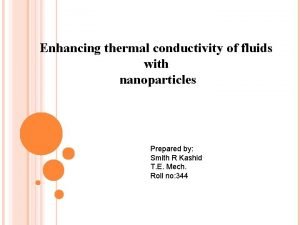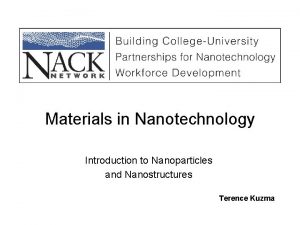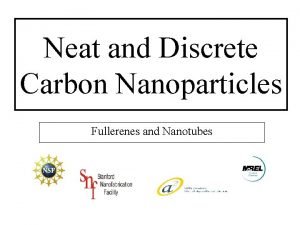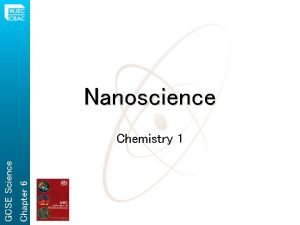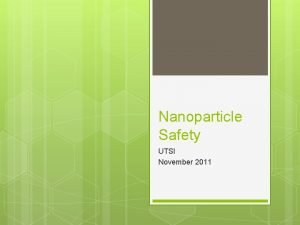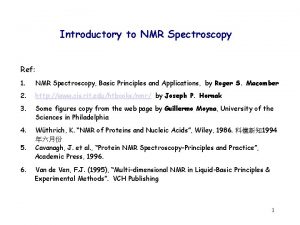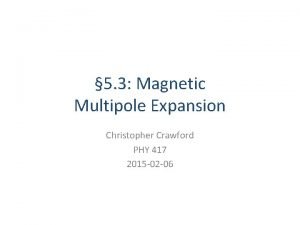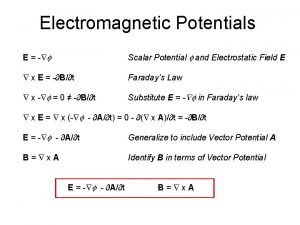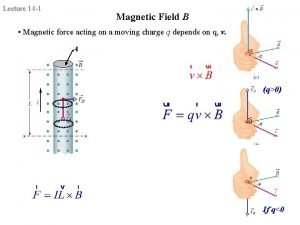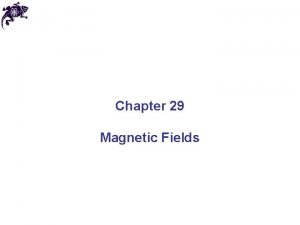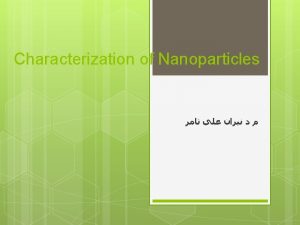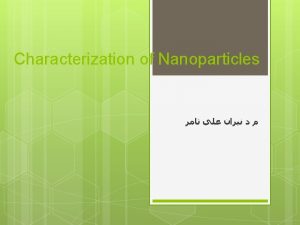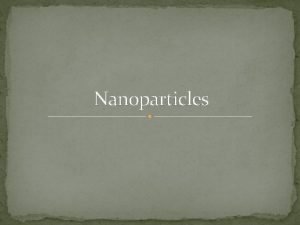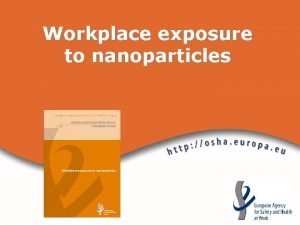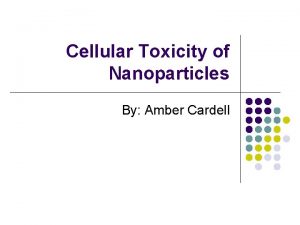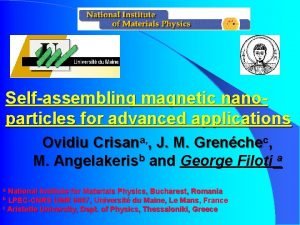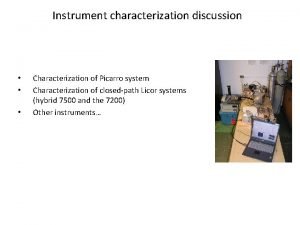Characterization of magnetic nanoparticles with potential applications in




















- Slides: 20

Characterization of magnetic nanoparticles with potential applications in cancer hyperthermia Jeffrey Camp Advisor: Dr. Cindi Dennis, NIST

• Hyperthermia – artificial heating of tumor cells, long studied as an alternative or supplement to chemotherapy • Externally applied heat damages healthy tissue • Magnetic nanoparticles (MNPs) heated inside the body by the application of an alternating magnetic field • Triggers cell death with only 4 -5 degrees heating A glioblastoma tumor in the parietal lobe. Metastatic brain cancers could potentially be treated by MNP hyperthermia. Image: Mayfield clinic

MNPs each have a net magnetic dipole from the effects of the internal electronic structure Vector sum is the “magnetization” S N The dipoles align in the presence of a field applied by an electromagnet There is some tendency for the dipoles to “stick” in one direction after the electromagnet is turned off

Hysteresis loops Gives magnetization as a function of applied field and magnetic history (“hysteresis”) of the material “Sticking” effect in dipoles causes open loop Area inside loop is equal to energy loss, most in the form of heat, an important design consideration for hyperthermia Shape exaggerated for magnetic nanoparticle

Technical challenges • Instrumental – large solenoid needed to deliver alternating magnetic fields (k. Hz), with huge power consumption (MW) • Biomedical – must be able to target to cancerous cells – Biocompatible • Chemical – narrow size and shape distribution, scalable

Technical challenges – Chemical –Magnetic, electrostatic, and intermolecular forces may cause clumping and settling out of solution Magnetic core Surfactant –A surfactant is needed to stabilize the MNPs by electrostatic or steric repulsion Citric acid surfactant

Synthesis • Three iron oxide nanoparticle systems synthesized at the University of Kentucky by coprecipitation of Fe+3 and Fe+2 in ammonium hydroxide • Iron oxide is biocompatible • “CART” sample reduced in the presence of citric acid at room temperature • “IS 80” sample reduced in the presence of citric at 80°C • “ 8080” made by a two step synthesis; first reduced in NH 4 OH at 80°C then reduced in citric acid

Magnetization (A*m^2/kg) Signal normalized to mass Small changes in synthesis conditions affect bulk magnetic properties! Black: IS 80 Blue: 8080 RED: CART Applied Field (A/m)

Torque curves T = MT*H*sin(Θm-ΘH) Torque MT = total magnetization, the vector sum of the parallel and perpendicular signals H = applied field ΘM = magnetization angle = tan-1(Y/X) ΘH = field angle, determined by physical orientation of magnet Angle

Torque (N-m) IS 80 dilution series anisotropy Black: 1: 1 Blue: 1: 2 Red: 1: 4 Angle (degrees)

Torque curve model fitting K 1*sin(Θ) + K 2*sin(2Θ) + K 4*sin(4Θ)…. • K 1 = unidirectional anisotropy constant • K 2 = uniaxial anisotropy constant • K 4 = bidirectional anisotropy constant We can “pull out” quantitative information about the behavior of magnetic nanoparticles in solution from the model coefficients

Uniaxial anisotropy energies (K 2) Black: IS 80 Anisotropy energy (J/kg) Blue: 8080 RED: CART Concentration %

Unidirectional anisotropy energies (K 1) Black: IS 80 Anisotropy energy (J/kg) Blue: 8080 RED: CART Concentration %

Why are there different signal strengths for equal masses of magnetic material? • Crystallinity – easy axis of magnetization Left: the crystalline structure of Fe 3 O 4 • Size effects – fewer surface spins • Collective behavior – reduces magnetization energy

Hysteresis loop model fitting • The Langevin Function: • M = N*µ*( coth( µ*H/ kb*T) – 1/( µ*H/ kb. T)) • N = number of atoms per unit volume • µ = magnetic moment per particle • H = applied magnetic field • Kb = Boltzmann’s constant • T = measurement temperature Models magnetic systems that are approximately paramagnetic Deviation from Langevin function may indicate interparticle interactions

Magnetization (A*m^2) Percentage difference between IS 80 dilutions and Langevin Black: 1: 1 Blue: 1: 2 % difference Red: 1: 4 Applied Field (A/m)

Magnetization (A*m^2) IS 80 hysteresis loops at 5 K, 50 K, 100 K, 200 K, and 300 K Applied Field (A/m)

In review: • Minor changes in synthesis conditions can affect magnetic properties that change value as a MNP hyperthermia agent • Collective behavior present in nanoparticles --Relevant to functionalization of nanoparticles -Good candidate for SANS study

Thanks to: • • Dr. Cindi Dennis Dr. Robert Schull Dr. Julie Borchers Dr. Andrew Jackson Center for High Resolution Neutron Scattering

Questions?
 Enhancing thermal conductivity of fluids with nanoparticles
Enhancing thermal conductivity of fluids with nanoparticles Introduction of nanoparticles
Introduction of nanoparticles Nanoparticles
Nanoparticles Lipid nanoparticles
Lipid nanoparticles Advantages of nanoparticles gcse
Advantages of nanoparticles gcse Introduction about nanoparticles
Introduction about nanoparticles Magnetic moment and magnetic field relation
Magnetic moment and magnetic field relation Magnetic force particle
Magnetic force particle Hysteresis loop magnetism
Hysteresis loop magnetism Air gap length formula
Air gap length formula What is indirect characterization
What is indirect characterization What does direct characterization mean
What does direct characterization mean Nmr applications
Nmr applications Multipole expansion griffiths
Multipole expansion griffiths Electromagnetic potentials
Electromagnetic potentials Magnetostatic field
Magnetostatic field Potential energy magnetic field
Potential energy magnetic field Electric potential due to dipole
Electric potential due to dipole Osmotic potential vs water potential
Osmotic potential vs water potential Calculating water potential
Calculating water potential Action potential resting potential
Action potential resting potential
